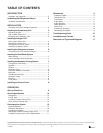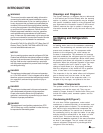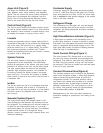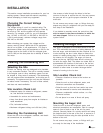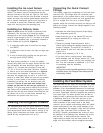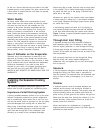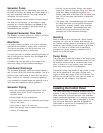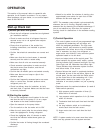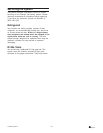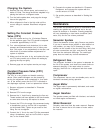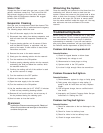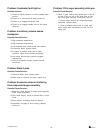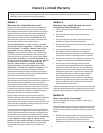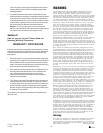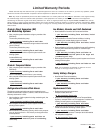
5
YY
YY
Y
English
L-2448B Installation
INSTALLATION
This section covers installation procedures for your ice
making system. Please read the manual completely
before attempting to install any equipment.
Choosing the Correct Voltage
Equipment
The voltage rating of a unit is a nominal rating. The
voltage in a given location may be higher or lower by
as much as 10% and the system will still operate
correctly. For example, at 60 Hz, you will sometimes
see 110 VAC to 120 VAC, or 208 VAC to 240 VAC. In
a 50 Hz environment, common voltages range from
220 VAC to 240 VAC.
When choosing your system, the voltage and fre-
quency must be known. While this 60 Hz equipment
can be run at 50Hz, it will experience a 17% drop in
performance. When using this equipment on 50 Hz, the
voltage must be the lower of the two voltages given
(100 or 200) on the data plate due to buildup of heat in
the motor.
Installing the Condensing Unit
Selecting the Site
Dometic ice making units are designed to be installed
in any convenient location. The unit is normally located
in the engine room or other machinery space, but can
be located in living areas if necessary. The condensing
unit will produce some condensation, so the drip pan is
necessary. The space around the unit may be insulated
to reduce noise if necessary. The unit is water cooled,
and does not need ventilation.
Site Location Check List
• Adequate space for access to refrigerant, seawa-
ter, and electrical connections
• Accessible for service and maintenance
• Away from direct spray from engine air intakes or
water washdown
• Flat, horizontal surface
• Maximum refrigerant tubing run is 50 feet (15m)
Mounting the Condensing Unit
Orient the unit so the refrigerant, seawater, and electri-
cal connections are accessible.
Use screws or bolts through the holes in the four
corners of the pan to secure the unit. You may remove
the pan and turn to get the proper orientation of the
drain stub.
Do not remove any covers, caps, or fittings that may
expose any wiring or refrigerant until you are ready for
that step of the installation.
If you decide to remotely mount the control box, be
sure to mount in the same orientation in which the
unit was shipped.
Failure to do so could cause
system failure.
Installing the Auger Unit
The auger is designed to be installed close to the ice
box. This minimizes the amount of tubing between the
box and auger, and minimizes the time required for ice
to start entering the box. It also helps to reduce the
amount of melting taking place in the hose and reduce
the chance for ice clogging. The auger unit has an
elbow on the top, right-hand side which is where the
ice exits the auger itself. The elbow can rotate 360
o
to
accommodate the location of the hose to the ice box.
It is important that the elbow is oriented in an upward
direction to allow water to re-enter the auger barrel
instead of running to the ice box.
Site Location Check List
• Choose a location as close to the ice box as
possible
• Orient the unit so that refrigerant, water, and
electrical connections are accessible
• Orient the unit so that the front and/or top cover
may be removed for service and maintenance
• Choose a substantial vertical surface, or a flat,
horizontal surface
• Do not place in an area of direct salt spray
Mounting the Auger Unit
Orient the unit so that the refrigerant, water, and
electrical connections are accessible. Plan for enough
space in front of and on top of the unit for panel
removal. Securely fasten to a sturdy vertical wall using
the keyhole slots in the rear of the unit, or secure to a
flat, horizontal surface using the tabs provided on the
bottom of the unit.
Do not remove any caps, covers, or fittings until you
are ready for that step of the installation.




